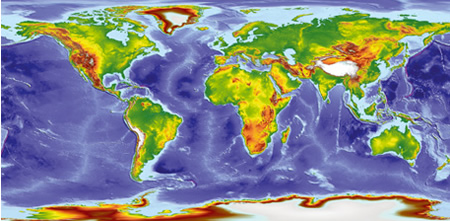Description
Radar altimeters are non-imaging radar sensors which use the ranging capability of radar to measure the surface topographic profile parallel to the satellite track. They provide precise measurements of a satellite’s height above the ocean and, if appropriately designed, over land/ice surfaces by measuring the time interval between the transmission and reception of very short electromagnetic pulses.
To date, most spaceborne radar altimeters have been wide-beam (pulse-limited) systems operating from low Earth orbits. Such altimeters are useful for relatively smooth surfaces such as oceans and low relief land surfaces, but are less effective over high relief continental terrain as a result of the large radar footprint.
ESA’s CryoSat mission will provide an instrument for the ice sheet interiors, the ice sheet margins, for sea ice and other topography, with three-mode operation:
- conventional pulse-limited operation for the ice sheet interiors (and oceans if desired);
- synthetic aperture operation for sea ice;
- dual-channel synthetic aperture/interferometric operation for ice sheet margins.
Successful exploitation of the height data is dependent upon precise determination of the satellite’s orbit. A number of precision radar altimetry ‘packages’ are available which contain:
- a high precision radar altimeter (with basic measurement accuracy in the range 2cm to 4cm);
- a means of correction for errors induced in the height measurements by variations in the amount of water vapour along the path (for example, by means of a microwave atmospheric sounder or radiometer);
- a high precision orbit determination system (typically based on GPS, the DORIS beacon/satellite receiver system and/or a lidar tracking system).
A variety of parameters may be inferred using the information from radar altimeter measurements. These parameters include: time-varying sea surface height (ocean topography), the lateral extent of sea ice and the altitude of large icebergs above sea-level, and the topography of land and ice sheets and even that of the sea floor. Topographical maps of the structure of the Arctic sea floor have not only revealed new mineral deposits, but they also provide new insights into how a large part of the ocean basin was formed some hundred million years ago.
Observations by current and future radar altimeters of trends in the ice masses of the Earth are of principal importance in testing of the predicted thinning of Arctic sea ice due to global warming, and will quantify the extent to which the Antarctic and Greenland ice sheets have contributed to the global rise in sea level. New generation radar altimeters are also providing useful information for the monitoring of inland waters (rivers and lakes levels) - as demonstrated by RA-2 on ENVISAT.
Satellite altimetry also provides information which is of use in mapping sea surface wind speeds and significant wave heights. Precision ocean altimetry applications for sea level monitoring and ocean circulation studies depend on more accurate, independent measurements of the geoid – derived from the instruments described in the ‘gravity field’ category.
The new generation of current and future instruments will provide more frequent data coverage and faster access to observations for incorporation into ocean circulation and wave forecast models used to generate marine information products.
 The world as seen by radar altimeters |
 Radar altimeters measure the distance between the satellite and the sea surface (E). The distance between the satellite and the reference ellipsoid (S) is derived by using the Doppler effect associated with signals emitted from marker points on the Earth’s surface as the satellite orbits overhead. Variations in sea surface height (SS, ie S-E), are caused by the combined effect of the geoid (G) and ocean circulation (dynamic topography, DT). |
| Current & planned instruments ALT POSEIDON-1 (SSALT-1) POSEIDON-2 (SSALT-2) POSEIDON-3 RA RA-2 SIRAL TOPEX |
JASON-1: www.jpl.nasa.gov/missions/current/jason-1.html |